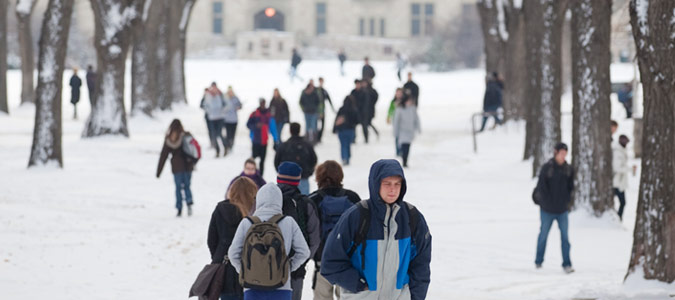Student census tells the U of S enrolment story
While student enrolment is up across the board at the U of S, data from the Oct. 11 census day showed plateauing numbers in two key recruitment areas—graduate and Aboriginal students.
By Colleen MacPherson "Our enrolment is up 2.9 per cent overall, which is the largest increase since 2003," said David Hannah, associate vice-president of student affairs, of the Enrolment Report data collected at the start of October. "It is particularly gratifying because the number of high school grads in Saskatchewan has been steadily declining. We not only held our ground, but made gains during this decline."
"Our enrolment is up 2.9 per cent overall, which is the largest increase since 2003," said David Hannah, associate vice-president of student affairs, of the Enrolment Report data collected at the start of October. "It is particularly gratifying because the number of high school grads in Saskatchewan has been steadily declining. We not only held our ground, but made gains during this decline."
This year's fall enrolment is the highest in U of S history, he explained, and is the third year of enrolment increases following long and steady decreases from 2003 to 2008. But equally important as the number of students, is the number of classes those students are taking.
"The number of three-credit units, or teaching activity, is up as well. That means more students are taking more classes. Fall term on campus teaching activity is up 3.6 per cent and off campus is up 8.9 per cent. This is significant because this is what generates tuition revenue. The ratio of students to credit units has been in decline so this increase is great."
Another highlight of the report is the significant gain in the number of international students now calling the U of SÂ campus home. "International student enrolments are up 11 per cent. We are very happy with this because it has been an area of emphasis in recruitment."
All of these increases are certainly positive, he continued, but a few red flags became apparent with the release of the enrolment data. One area that Lawrence Martz, dean of the College of Graduate Studies and Research, pointed to is graduate student enrolment.
"The number of graduate students continues to grow, but at a lower rate than in the last couple of years. It has plateaued somewhat this year," said Martz. "To meet the university's goal of 20 per cent graduate students by 2015, our annual graduate enrolment growth needs to be sustained at the rate of about eight per cent that we have had over the past two years. This year's growth of 4.2 per cent (and) therefore, is a cause for some concern."
Another area of concern is the number of self-declared Aboriginal students on campus, which has not changed noticeably for several years, Hannah said. "Our goal is to have Aboriginal students make up 15 per cent of the student population by 2020. We haven't moved the needle on this group of students for a while, and have been hovering around eight per cent since at least 2007."
All in all, Hannah said, "this year's enrolment is a good news story." And to ensure this momentum continues in the years ahead, the university—with the help of outside consultants—will be developing a Strategic Enrolment Management (SEM) plan that will guide the university's enrolment goals through to the end of the decade.
"The SEM plan should be ready by the end of next summer. It will identify enrolment goals at the college and university levels. It is a long-term planning activity that will analyze and factor in external and internal factors, like size and diversity of the student body, the demand for our programs, our institutional position relative to our competitors, provincial demographics and economic data, etc."
The SEM plan will be informed by the integrated planning process while also ensuring colleges remain involved in the process and have their goals reflected in the plan, he explained. "SEM will make sure goals are aligned at all levels of the university and that we recognize our position in the postsecondary environment and our capacity. The plan will allow us to better analyze and measure our recruitment and retention data."

